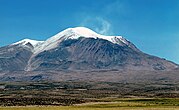User:Allard
Hello and a warm welcome to all my fellow Wikipedians. How nice of you to drop in to see who I am!
Morning>
Wikipedia & me:[edit]
How I discovered Wikipedia, I do not remember. But from being a reader I slowly became a contributor. Although I don't work that much on Wikipedia I do see myself as a Wikipedian. I don't go searching on Wikipedia what I can edit next, I edit what I find and want to do. This means I add and mainly improve a lot of small things and only rarely I make large edits.
My work:[edit]
Articles I've started on Wikipedia:
- Fort Knox Bullion Depository
- Animals are Beautiful People
- Template:David Attenborough Television Series
- Template:Malta Islands
Images I made for Wikipedia:
 Dutch lower house as from 2006
Dutch lower house as from 2006 New image of the Netherlands Air Force Roundel
New image of the Netherlands Air Force RoundelMap on membership of the League of Nations
United Nations membership map
 Improved image of the British Helgoland flag
Improved image of the British Helgoland flag New image showing the current flag of Hel(i)goland
New image showing the current flag of Hel(i)goland
Article guide:[edit]
A list of articles worth looking at, if one can find them:
- Antidisestablishmentarianism
- Ball's Pyramid
- British Isles (terminology)
- Eadweard Muybridge
- Gunpowder Plot
- Horace de Vere Cole
- Humphrey (cat)
- Islomania
- List of countries by date of nationhood
- List of flags
- List of people who died on their birthdays
- List of regnal numerals of future British monarchs
- List of unusual deaths
- Northwest Angle
- Quadripoint
- Racetrack Playa
- Rule of tincture
- San Gimignano
- Transcontinental country
- Undivided India & Partition of India
- Voyager Golden Record
- Web colors
- Winchester Mystery House
And there's always the Random article
And to all citizens of the European Union, please read this: Oneseat.eu
News[edit]
- Flooding (pictured) in the Arab Gulf states leaves at least twenty-four people dead.
- The historic Børsen in Copenhagen, Denmark, catches fire.
- A knife attack in Sydney, Australia, leaves seven people dead.
- In retaliation for an Israeli airstrike on the Iranian consulate in Damascus, Iran conducts missile and drone strikes against Israel.
- In the South Korean legislative election, the Democratic Party–led opposition alliance increases its majority in parliament.
Selected anniversaries[edit]
April 19: Feast day of Saint Alphege of Canterbury (Catholicism, Anglicanism), Education and Sharing Day in the United States (2024), Primrose Day in London
- 1773 – The Polish Partition Sejm met to discuss the First Partition of Poland, carried out the previous year by Russia, Prussia and Austria.
- 1809 – War of the Fifth Coalition: French general Louis-Nicolas Davout defeated an Austrian force in Lower Bavaria, allowing him to rejoin the main French army.
- 1927 – American actress Mae West (pictured) was sentenced to ten days in jail for "corrupting the morals of youth" with her play Sex.
- 1989 – A gun turret exploded on board the United States Navy battleship Iowa, killing 47 sailors.
- Uesugi Kenshin (d. 1578)
- Elizabeth Dilling (b. 1894)
- Denis O'Brien (b. 1958)
Did you know...[edit]
- ... that there is an East Quoddy Head Lighthouse (pictured) and a West Quoddy Head Lighthouse on opposite sides of a bay, but one is in Canada and the other is in the United States?
- ... that Dahiru Musdapher, the 12th chief justice of Nigeria, was once a BBC World Service contributor for West Africa and Hausa?
- ... that To Catch a Copper hoped to show "an enjoyable journey of officers solving cases", but discovered "a misconduct process that was unfit for purpose in addressing seriously concerning behaviour"?
- ... that in 1848 Karl Schädler performed the first surgery with chloroform anaesthesia in Liechtenstein?
- ... that the planned sale of a Texas TV station was the subject of a lawsuit more than seven years after it closed for the last time?
- ... that Bob Born became known as the "Father of Peeps" for automating the production of an Easter marshmallow treat?
- ... that food critic Grace Dent reviewed a Liverpool restaurant that served her rice pudding flavoured with a substance that is banned in the United States for its lethality?
- ... that it took four games for Todd Leslie to set the NCAA Division I record of fifteen consecutive three-point shots made?
- ... that Young Dirty Bastard rapped despite Ol' Dirty Bastard telling him not to?
Today's featured article[edit]
Guallatiri is a stratovolcano in Chile that is 6,060–6,071 m (19,880–19,918 ft) high. It is located southwest of, or possibly within, the Nevados de Quimsachata volcanic group. The summit, surrounded by numerous fumaroles, may be a lava dome or volcanic plug, while the lower flanks of the volcano are covered by lava flows and lava domes. The volcano's eruptions have produced mostly dacite along with andesite and rhyolite. Past glaciation has left moraines on Guallatiri. A large eruption took place approximately 2,600 years ago. Guallatiri has been active since prehistoric times, with the latest known eruption in 1960. Fumarolic and seismic activity is ongoing and has resulted in the deposition of sulfur and other minerals on the volcano. It is covered by an ice cap above 5,500–5,800 m (18,000–19,000 ft) elevation that has retreated and broken up into separate ice bodies. Part of Lauca National Park, Guallatiri is monitored by the Chilean National Geology and Mining Service. (Full article...)











